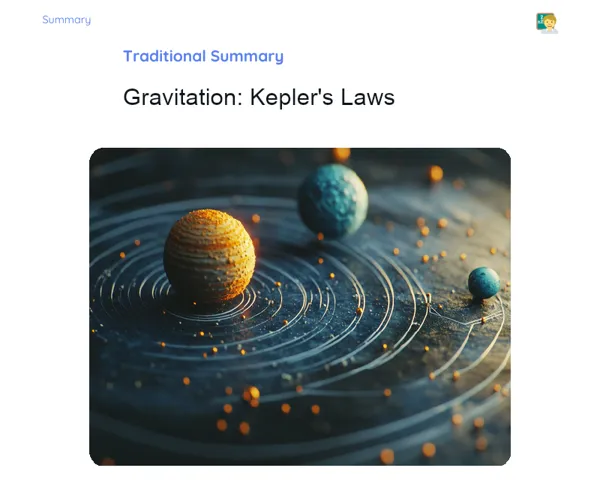Socioemotional Summary Conclusion
Goals
1. Grasp the concept of inertia and its relevance to Newton's 1st Law.
2. Understand that an object at rest or moving in a steady straight line has zero acceleration, meaning all the acting forces balance out.
Contextualization
Picture yourself on a local bus when the driver suddenly hits the brakes. Why does your body lurch forward? 🤔 This is inertia at play – a key concept in physics that can assist you in staying calm and focused during times of change. Let's explore how Newton's 1st Law influences various aspects of our daily lives! 🚀
Exercising Your Knowledge
Principle of Inertia
Newton's 1st Law, commonly referred to as the Law of Inertia, tells us that an object at rest stays at rest and an object in motion continues to move in a straight line unless something else affects it. This principle helps us understand how different forces impact an object’s motion and is a cornerstone in the study of physics.
-
Inertia is the tendency of an object to resist any change in its current state of motion.
-
An object at rest will only start moving if a considerable external force acts upon it.
-
Likewise, an object in motion will only stop or alter its path if an external force intervenes.
-
You can observe this principle in everyday scenarios, like when a vehicle suddenly brakes, causing passengers to lurch forward.
Zero Net Force
Zero net force takes place when the sum of all forces acting on an object equals zero. In this case, the object remains in its current state: if it is stationary, it stays stationary; if it is moving, it continues to move in a straight line. This is vital for understanding stability in physical systems.
-
Zero net force indicates that all forces cancel each other out, leading to a total force of zero.
-
When the net force is zero, a stationary object will remain stationary.
-
If the net force on a moving object is zero, it will keep moving at the same speed.
-
This state explains why an object can seem motionless or maintain a constant speed without any change.
Coin and Card Experiment
This hands-on experiment illustrates the principle of inertia using simple materials: a glass, a card, and a coin. By swiftly pulling the card, the coin drops into the glass because of inertia. This demonstration is a clear and visual representation of Newton's 1st Law in action.
-
Start by placing a card over the opening of the glass with a coin on top.
-
When you quickly pull the card, the coin remains in its state of rest thanks to inertia.
-
As the card is pulled away, there’s nothing left to hold the coin, causing it to drop into the glass.
-
This straightforward experiment shows how inertia operates in a tangible manner.
Key Terms
-
Newton's 1st Law: Commonly called the Law of Inertia, stating that an object at rest or in uniform straight motion will remain so unless an external force acts on it.
-
Inertia: The property of an object to resist alterations in its state of motion.
-
Net Force: The vector sum of all forces acting on a given object.
-
Uniform Straight-Line Motion: Motion along a straight path at a constant speed, indicating zero acceleration.
-
Equilibrium: A condition where the net force on an object is nil, keeping its state of motion unchanged.
For Reflection
-
How can you apply the idea of inertia to stay composed in stressful or changing situations?
-
How might understanding zero net force prompt you to take action in changing circumstances in your life?
-
Think back to a recent challenge you encountered. How did your emotions shape your responses, and how might you have implemented emotional regulation strategies for better handling?
Important Conclusions
-
Newton's 1st Law, or the Law of Inertia, shows us that a body is inclined to maintain its state of motion, whether at rest or moving straight, unless an external force is introduced.
-
Grasping inertia is essential for comprehending how objects interact and move in our everyday experiences.
-
The concept of zero net force is significant for understanding how physical systems can remain balanced, upholding a consistent state of motion.
Impacts on Society
In our everyday life, the application of Newton's 1st Law can be observed in various situations, such as safety while commuting. The use of seatbelts, for example, is grounded in the principle of inertia: they keep us securely in our seats during sudden stops, preventing us from being thrown forward. Understanding this principle allows us to make safer choices in our daily routines.
Additionally, inertia can also mirror our emotional responses. Just as an object resists shifts in its motion, we can also resist emotional changes. Recognizing this tendency enables us to manage our emotions more effectively and act in a balanced manner during emotionally challenging scenarios, be it in school, at home, or within the community.
Dealing with Emotions
To manage your emotions effectively while studying Newton's 1st Law, try applying the RULER method. First, Recognize your emotions: How did you feel when learning about a new concept? Perhaps a mix of curiosity, frustration, or excitement? Understand what spurred these feelings: Was it the complexity of the lesson or the joy of learning something new? Label your emotions accurately. Express these emotions in a healthy way, whether by conversing with friends or documenting in a journal. Lastly, Regulate your emotions: Embrace techniques like deep breathing or meditation for calming and refocusing. Practicing this during your studies may enhance your performance and overall well-being.
Study Tips
-
Create summaries and mind maps regarding Newton's 1st Law. Visualizing information in various formats can aid retention.
-
Put the concepts learned into practice through everyday observations, like analyzing the motion of vehicles or items around your home, explaining these phenomena using the principle of inertia.
-
Form study groups to discuss the material and try out experiments together. Learning collaboratively can provide fresh insights and make studying less monotonous and more enjoyable.



